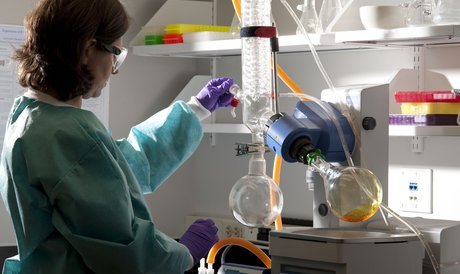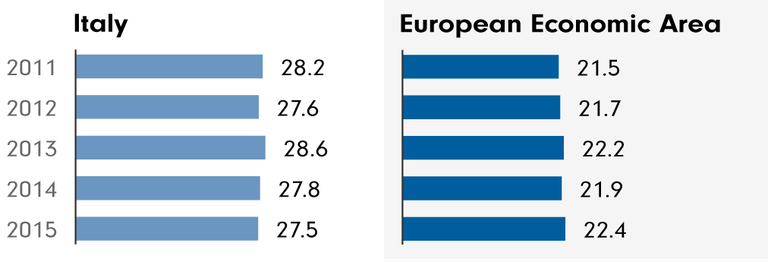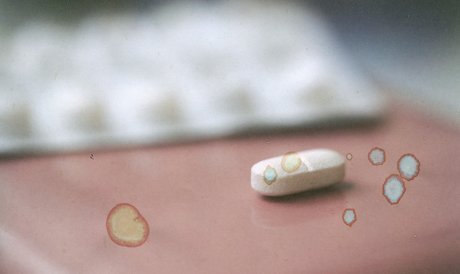
Italy
The emergence of bacteria that cause infections in humans which are resistant to treatment with antibiotics has become a global public health concern.
Infections by multi-resistant germs are estimated to kill around 25,000 people in the EU every year, with some experts estimating that this number will increase dramatically over the coming decades.
But the situation between each member states varies hugely. Some countries have strict rules around antibiotic consumption and some don’t. The EU bodies responsible for addressing the problem recognise that there is no one-size-fits-all solution. This is why it is important to understand the situation in individual countries.
Antibiotic resistance in Italy
In Italy, multi-resistant bacteria are on the rise. This is reported by the European Center for Disease Prevention and Control (ECDC), which collects and compares data from European hospitals. Italy has some of the highest results in the statistics. For example, every second E. coli infection tested is resistant to the critical antibiotic fluoroquinolone – which is the highest record in Europe.
MRSA prevalence
Percent of hospital Staphylococcus aureus isolates that are resistant to methicillin

Source: ECDC
Italy has above average antibiotic consumption both in and outside hospitals.
The situation in livestock production is similar: twice as many antibiotics are used per kilogram of meat produced as the average – only in Cyprus is livestock consumption of antibiotics higher. The European Medicines Agency publishes data on antibiotic consumption in livestock. In 2014, 1,431.6 tonnes of antibiotics were sold for use in food producing animals. This was the second highest figure in the EU, after Spain.
Antibiotic consumption in humans
Daily doses per 1000 inhabitants per day

Source: ECDC
Human consumption of antibiotics
According to the ECDC, which published the data, 2.2 daily doses of antibiotics were taken per 1,000 people in Italian hospitals. This was higher than the EU average of 2.0 daily doses per 1,000 people.
Outside of hospitals, in 2014, 27.8 daily doses of antibiotics were taken per 1,000 people in Italy. This was above the EU average of 21.6 daily doses per 1,000 people.
Hospital infections
The ECDC also records healthcare associated infection (HAI) prevalence in European hospitals. This data shows what percentage of hospital patients have a hospital acquired infection – a large proportion of these infections are preventable, and are caused by poor hygiene.
The European average for HAI prevalence was 6.12%. In Italy, this number was close to the average at 6.3%.
Why are so many antibiotics swallowed in Italy, and why are the number of resistant bacteria increasing? One reason is that the country's health system is highly regionalised. When it comes to their health policy, the 21 provinces of Italy can independently decide many things for themselves. This makes coordinated efforts against antibiotic resistance more difficult.
Additionally, there is a lack of reliable data available to help evaluate the situation. Even for scientists, the data is inaccessible. About 50 hospitals report incidents of resistant pathogens to the National Institute of Health and the Ministry of Health. Theoretically, these data are also accessible to journalists and the general public. In practice, however, the authorities almost never issue statistics.
Other indicators
An ECDC report which looked at infections and antibiotic use in European hospitals in 2011-12 reported on hospitals indicators like the use of alcohol hand rub and the number of single beds.
These indicators are important because they are measures that help to keep the rate of hospital acquired infections low, which helps to counter resistance – because the fewer infections patients acquire, the fewer antibiotics are used, and the less resistance can develop.
Single rooms are important because they can be used to isolate patients who have infections, preventing the infection from spreading. The amount of alcohol hand rub used indicates how well hospital staff are disinfecting their hands and following hygiene procedures – the more hand rub used, the less chance infections have of spreading.
Italy had one of the lowest uses of alcohol hand rub in its hospitals of all the countries the ECDC gathered data from, using just 8.16 litres of hand rub per 1,000 patient days. The European average was over three times higher at 25.64 litres. Only Hungary, Lithuania and Romania had a lower use of alcohol hand rub in their hospitals.
Italy also had a very low proportion of hospital beds that were in single rooms compared to the European average. The ECDC report found that just 5.88 per cent of hospital beds in Italy were in a single room, as a proportion of total beds, compared with the European average of 15.29 per cent.
However, when it came to the number of doctors and nurses in each Italian hospital dedicated to infection prevention and control Italy was above the European average in both categories. Italy had an average of 1.16 infection nurses in each hospital per 250 beds, compared to a European average of 0.97 infection nurses. And on average Italy had 0.76 dedicated infection doctors per 250 beds, higher than the European average of 0.38.
-

-

Seven things YOU can do to combat antibiotic resistance
Because we can all help in the fight against resistant bugs.
-

A new TV documentary reveals that superbugs are multiplying in the polluted wastewater flowing from pharmaceutical plants in India
-

Less than half of antibiotics used in hospitals worldwide are prescribed appropriately, confirms a comprehensive new study
-

Projected death toll from drug-resistant superbugs 'based on incomplete data and flawed assumptions'
-

More antibiotics, more resistant germs
Antibiotic consumpion varies largely between countries
-

Lost life
More than two million Europeans are infected in hospital every year, according to the most comprehensive study to date
-

Fear of Bacteria
Why resistances against antibiotics has rather become an overestimated than an underestimated problem.
-

Intransparent Resistance
Resistant germs are common in Italy and use of antibiotics is among the highest in Europe
